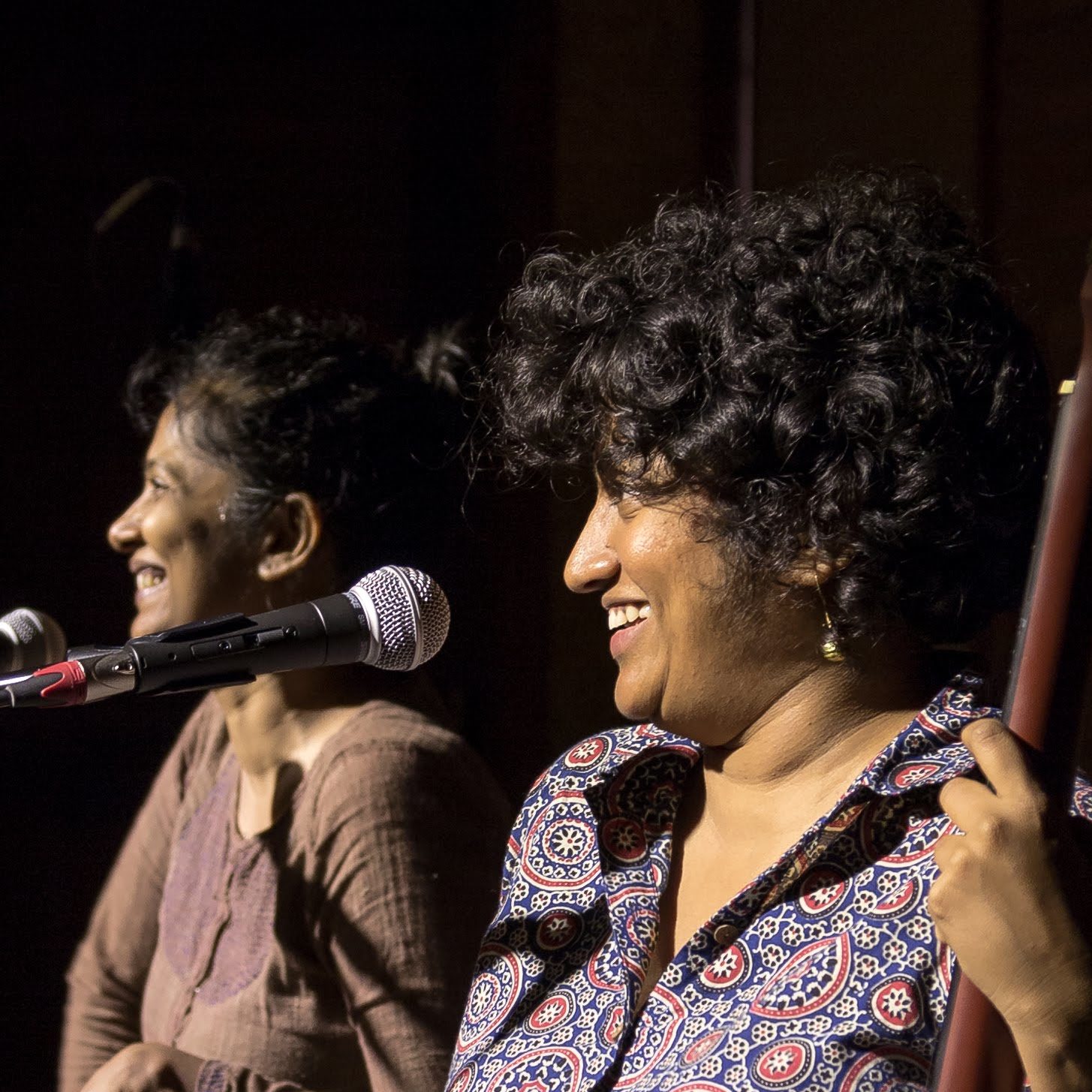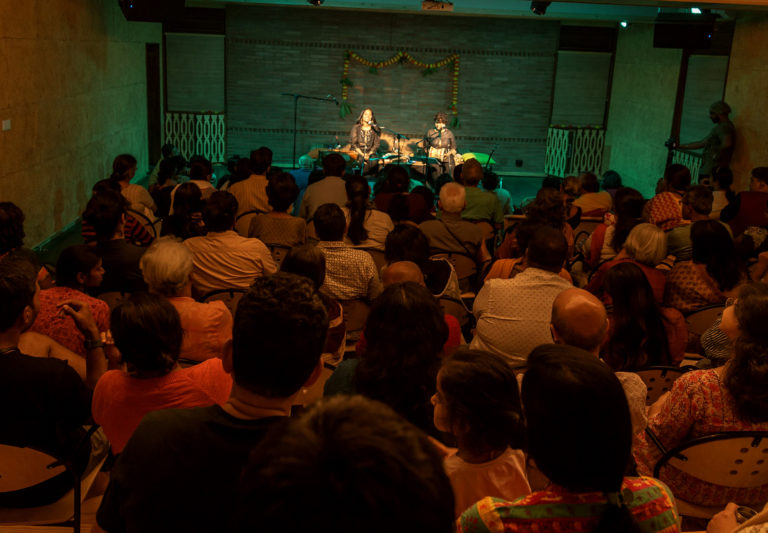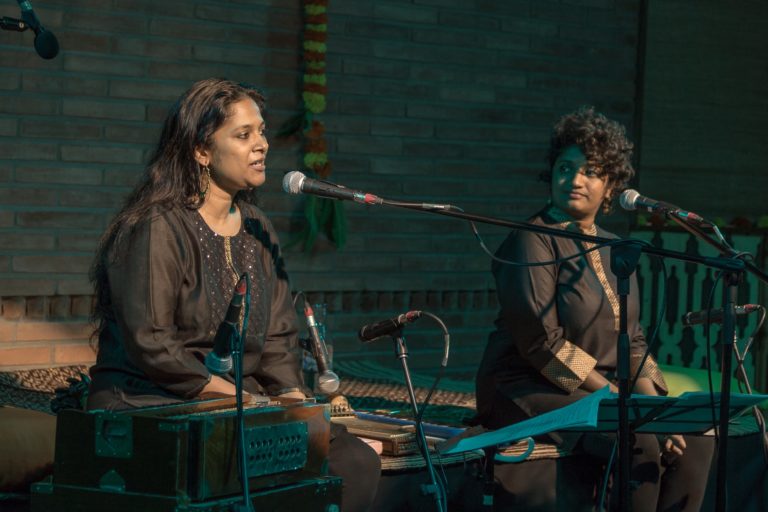Category
Music

Music
Bindhumalini and MD Pallavi.
August 5th 2018.

August 5th 2018 – Courtyard Koota resonated with the voices of Bindhumalini and MD Pallavi for its very first show- which ran to a full house!! The exploration of thoughts and expression set the tone for the place- powerful and moving. Sharing stories of women through generations and contexts -their struggles and their victories, through music and poetry – it was a gripping performance that had us angry, sad and hopeful in turns. It was very special to have Bindhumalini for our first performance as she has been a strong influence in conceptualising Koota. As it is with perfomances, so also with the performance space, the excitement and tension of a show going off without a glitch was a new feeling which has become a part of us now, after a year.
As Bindhu says in the article below “The Threshold is a living, breathing piece; we can always dip into it. We can keep changing it, adding and removing bits. It’s very flexible that way.” We eagerly await the time when newer versions of “The Threshold” will immerse the audiences at Courtyard Koota.
Here is a reposted article on The Threshold in the firstpost by Suryasarathi Bhattacharya.
“Imagine an eleven-year-old girl, performing the most difficult sonatas and concertos of the greatest composers, on the harpsichord or fortepiano, with precision, with incredible lightness, with impeccable taste. It was a source of wonder to many,” reads a review of one of Maria Anna Mozart’s performances as a child. Though they are limited in number, much of the reviews and family letters indicate that Maria Anna may have been a bigger musical genius than her famous younger brother, the legendary composer Wolfgang Amadeus Mozart. Researchers even claim she had a huge role to play in the orchestration of some of Mozart’s works over the years. Despite this, while her brother became a worldwide phenomenon, Maria Anna remains just a name and her music — never documented — has been lost. In this era, women, particularly of the middle class, were not allowed to perform at public events, and even if they did, they had to play for nothing.
Stories like this form the backbone of The Threshold, a musical piece featuring the works of remarkable women across the world, spanning generations. From the journeys of Agnodice (fourth century BCE), Hypatia (350 AD), Kharboucha (late 19th century), Fanny Mendelssohn (1805-1847) to the songs of Lal Ded (1320-1392), Lingamma, Neelamma, Goggavva, Sule Sunkkavva (all around the 12th century), Meerabai (1498-1547) and Nina Simone (1933-2003), The Threshold explores and celebrates gender through a musical dialogue. MD Pallavi and Bindhumalini Narayanaswamy spearhead this project, with their vocals accentuated by the sounds of a plethora of instruments, such as the harmonium, flute, kazoo, swarmandal, udukkai, bells, ghungroo, shakers, kartal, melodica, rainmaker and the banjo.
 Bindhumalini, who has staged various performances on Kabir and other mystic saints of India, was approached by Pallavi to collaborate on a new subject for a women’s festival a few years ago. What The Threshold is today, is because of the conversations they shared, she says. Speaking about how this performance was conceived and executed, Pallavi says, “There were two things that we looked into. Firstly, content-wise, we wanted to explore and collect as many different stories as possible from different corners of the world. Secondly, what form do we present the pieces in? What is the kind of language or design the whole piece must have? In the very beginning, we made a choice that it is not going to be a band. It’s just the two of us on the stage and nobody else. We perform, we sing, we tell stories, we play our instruments. We didn’t want to restrict ourselves to the Indian form only, but obviously, at the same time, we had to draw on our strengths.” The variety of music chosen is a testament to the performance’s diversity: If there’s a bandish in Raga Puriya Dhanashree, there’s also Raga Megh Malhar; if there’s a Moroccan composition of Kharboucha, there’s also Notturno (in G minor) by Fanny Mendelssohn.
Bindhumalini, who has staged various performances on Kabir and other mystic saints of India, was approached by Pallavi to collaborate on a new subject for a women’s festival a few years ago. What The Threshold is today, is because of the conversations they shared, she says. Speaking about how this performance was conceived and executed, Pallavi says, “There were two things that we looked into. Firstly, content-wise, we wanted to explore and collect as many different stories as possible from different corners of the world. Secondly, what form do we present the pieces in? What is the kind of language or design the whole piece must have? In the very beginning, we made a choice that it is not going to be a band. It’s just the two of us on the stage and nobody else. We perform, we sing, we tell stories, we play our instruments. We didn’t want to restrict ourselves to the Indian form only, but obviously, at the same time, we had to draw on our strengths.” The variety of music chosen is a testament to the performance’s diversity: If there’s a bandish in Raga Puriya Dhanashree, there’s also Raga Megh Malhar; if there’s a Moroccan composition of Kharboucha, there’s also Notturno (in G minor) by Fanny Mendelssohn.
Pallavi and Bindhumalini don’t just sing; they also recite poetry and read texts during the performance, and all of it comes together to form a holistic musical offering. Pallavi, who has been active in the mainstream as well as indie music scenes for a while now, reveals that while some of the songs in the performance are well known, the other pieces are obscure ones found as a result of research. “We had many ‘this-story-led-to-this’ moments during our research. It’s a mix of women we know and we don’t know, stories we know and we don’t know. There are some stories that are usually told in a certain way, but here we tell them differently,” says Pallavi.
For both of them, the approach to this performance was spontaneous and unstructured. Since they started from close to nothing, it meant the whole world was out there to explore. “We made certain choices about first exploring only women, although we did collect stories of men and other genders across the spectrum too. But we found there was enough material already. Sometimes we stumbled upon poems that we already had, and we saw that they were very beautiful and philosophical. So we just started composing them, and in the process, we felt there was some kind of a connection in these poems,” says Bindhumalini. Pallavi adds, “We found that the journeys of women seem to be similar across places: Hypatia’s journey or one of her experiences is probably very similar to an experience that Sule Sunkkavva (a prostitute who wrote poetry as part of the Vachana movement) witnessed. We are trying to juxtapose women from across different lands and different times.”

Though Pallavi and Bindhumalini are the only two people on stage during the one-hour act, they manage to keep the audience’s attention right till the end. They believe The Threshold is not just about their voices, it is a “collective movement”. Pallavi asserts it is not an “aggressively feminist” performance but rather, in its essence, it is an attempt to look at the question of gender through the lens of compassion.
“In the folk tradition, there are wailing songs from Tamil Nadu where hundreds of women sing when they know they are going to lose a child if it is a girl. It is a tradition which is quite tragic in nature. Expression of this kind has also led to awareness,” explains Pallavi. She adds, “We tell Fanny Mendelssohn’s story and we sing one of her pieces. We know she was not allowed to publish her works for the longest time under her own name, but she was able to do so under her brother Felix Mendelssohn’s name. There’s no agenda here. Many songs and stories in this performance make you realise that today, we are able to do this because some woman/ man/ community went through some kind of struggle.” According to Bindhumalini, The Threshold is also about celebration and in that way is also very inclusive in its spirit. “It is not about going out and pointing fingers. It is about weaving together facts and stories through these songs,” she says.
Pallavi and Bindhumalini are trained in classical music and their proficiency in the genre is evident in the way each of the 17 songs in the performance organically come together. “Our training does come into the picture,” Bindhumalini explains, “it gives us the ability to examine different kinds of voice production, different styles of singing. It’s a very different approach to creating something that we wouldn’t have explored otherwise.” The instrumentation and rendering of these songs depend on a number of factors, such as the content of the piece itself, what it says, what kind of a poem it is, the language, the rhythm, the tempo, and finally what soundscape it is creating. Bindhumalini adds, “We also look at what the poetry evokes in us, that emotion guides us to the composition.”
Just as the lamp on the doorsill sheds
Light inside and outside the house,
The sharana sees inside and outside his body
He knows, he forgets,
He sees, he does not see.
When the mind which thinks,
The eyes which see,
The object which is seen,
All three merge and become one,
The sharana in bliss merges in God.
The above verse, written by the 12th-century mystic saint Lingamma from Karnataka, was the inspiration behind the name The Threshold, that eventually became the central theme of the entire performance. Pallavi says that Lingamma, in this poem titled ‘Hosthilollage Irisida’, is constantly talking about opposites co-existing. “Your awareness and understanding are at the doorstep. You are taking in all the information being given to you from the outside and you are also processing things from inside. Your gender is formed because of these processes inside and outside.” On the subject of how this poetry and its meaning informed the composition, Bindhumalini says, “In the piece, we decided there should be a lower octave and a higher octave — so that there is a constant mirroring, a constant interaction between the two.”
The duo believes this evolving facet of The Threshold has also influenced them as individuals and their perception of gender dynamics in the society. “What it has really taught us is, how do you not make it seem like you are advocating something, in a piece that predominantly talks about gender?… This piece looks at gender, gender performance and gender roles and what they are constantly doing or have done to each individual — whether they are male or female. Everybody goes through their own gender-related dilemmas and challenges. The Threshold is a living, breathing piece; we can always dip into it. We can keep changing it, adding and removing bits. It’s very flexible that way,” concludes Bindhumalini.